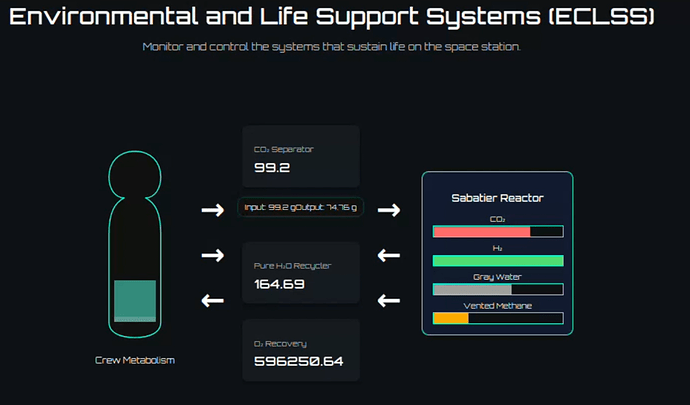Space Station OS v0.8.3 Released – ECLSS Integration, GNC Parameterization, and Sensor Updates
We are pleased to announce the release of Space Station OS v0.8.3, featuring the first integrated version of the Environmental Control and Life Support System (ECLSS), along with important updates to the guidance and control (GNC) and sensor subsystems.
Release Notes:
Highlights of v0.8.3
-
ECLSS Integration:
Core components such as air revitalization and water loop modeling are now included in the SSOS simulation. -
GNC Parameterization:
CMG and thruster configurations have been parameterized for greater flexibility and reusability. -
Sensor Updates:
Improved IMU simulation, including configurable bias and noise parameters, lays the foundation for future estimation modules. -
Preliminary CMG Unloading Framework:
Core structure introduced for CMG unloading logic (currently under active development).
These updates enhance the realism, modularity, and extensibility of SSOS across multiple subsystems.
System Overview
This version also includes early-stage integration of the following subsystems and control mechanisms:
-
Environmental Control and Life Support System (ECLSS)
Simulates human metabolic processes including oxygen generation, CO₂ scrubbing, and water recycling. -
Thermal Control System (TCS) (in progress)
Designed to manage internal heat via dynamic coolant loops, ammonia-based external loops, and radiator logic (with heater safeguards). -
Space Station Control System (in progress)
Enables full 6-DOF control and real-time teleoperation via keyboard inputs, built entirely in ROS 2 and simulated in Gazebo Harmonic.
ECLSS System Details
The ECLSS module simulates key life support functionality by modeling:
- Oxygen generation and carbon dioxide removal, with closed-loop gas balance,
- Water recycling, including phase-change modeling and humidity control,
- Resource budgeting and system alerts for life-critical thresholds,
- Integration with sensor data to reflect real-time changes in environmental conditions.
This implementation mirrors subsystems used on the ISS and lays the foundation for autonomous fault detection and long-duration habitat modeling. Future updates aim to incorporate power consumption, crew metabolic models, and contingency protocols.
Operational Demo: How It Works
This version takes architectural and visual inspiration from the HAVEN-1 space station by Vast.
- A. ECLSS manages O₂, CO₂, and H₂O levels, simulating closed-loop atmospheric control.
- B. TCS circulates coolant internally, then rejects excess heat through ammonia-based external loops and rotating radiator panels (represented visually as solar arrays).
- C. Teleoperation uses keyboard inputs to send commands to spacecraft thrusters or CMGs, based on interfaces inspired by the
space-rosdemo from David Dorf.
These systems are currently running in full simulation mode with console-based logs. The next step is Hardware-in-the-Loop (HITL) testing.
Repository and Participation
GitHub Repository:
If you are passionate about robotic autonomy, space systems, or simulation-first design, we welcome your contributions and feedback.
ros2 #SpaceStationOS #ECLSS #ATCS #GNC imu simulation #OpenSource #HITL #GazeboHarmonic robotics
